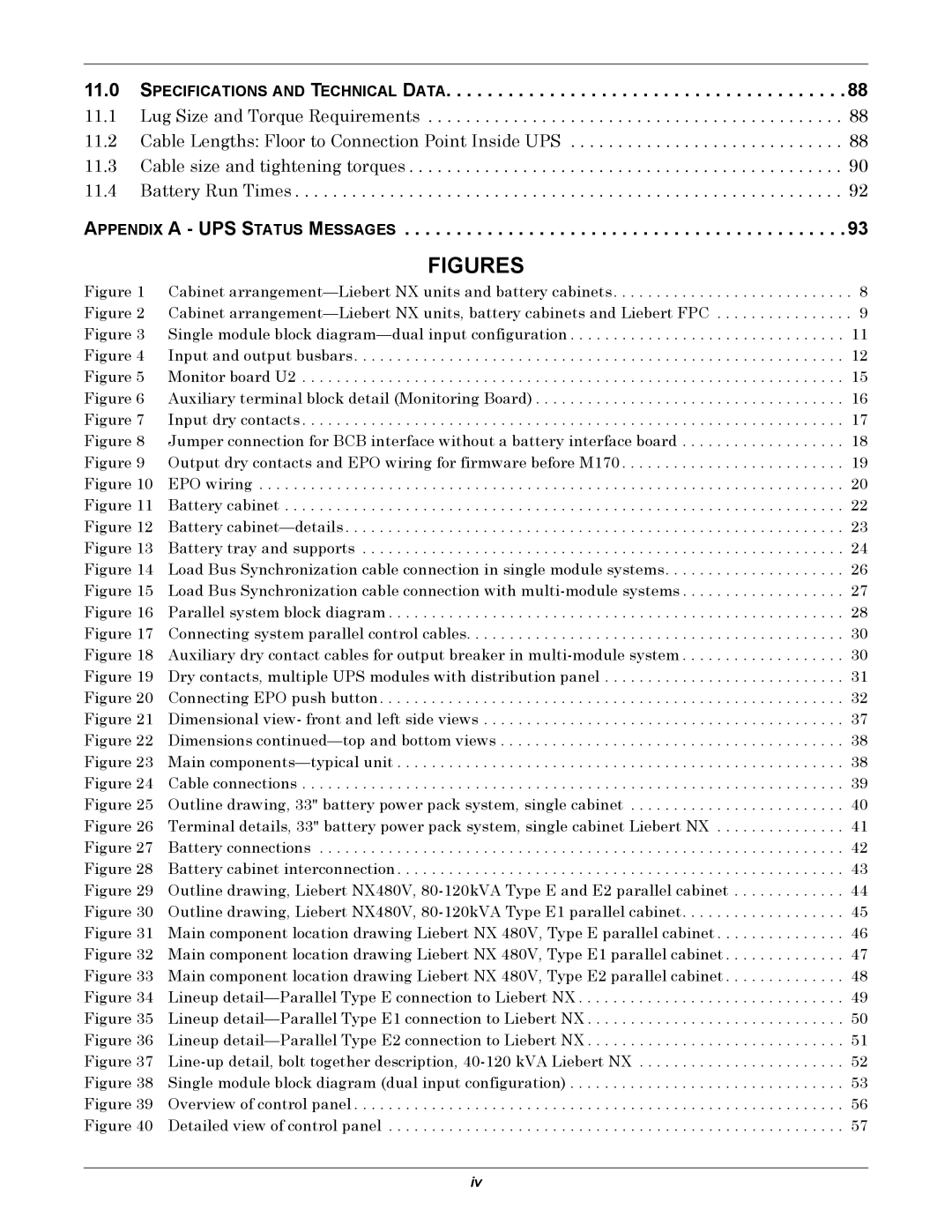Liebert NX UPS
Page
Table of Contents
UPS Specifications
Options
Operator Control and Display Panel
Operating Instructions
Pop-Up Windows
Specifications and Technical Data
Appendix a UPS Status Messages
Tables
Page
Important Safety Instructions
Battery Cabinet Precautions
Glossary of Symbols
Installation
External Inspections
Internal Inspections
Preliminary Checks
UPS Location
Mechanical Considerations
Battery Location
Considerations in Moving the Liebert NX
Special Considerations for Parallel Systems
Cable Entry
Floor Installation
Clearances
System Composition
Cabinet arrangement-Liebert NX units and battery cabinets
UPS
Power Cabling
Cable Rating
Lug Size and Torque Requirements
UPS Input Configuration
Cabling Guidelines
Cable Connections
Input and output busbars
Safety Ground
Protective Devices
UPS Rectifier and Bypass Input Supply
Common Input Connections
Cabling Procedure
Output System Connections-Ensure Correct Phase Rotation
Dual Input Connections
Frequency Converter Mode
Monitor Board Features
Control Cables
Dry Contacts
Input Dry Contacts
Maintenance Bypass Cabinet Interface
Maintenance bypass cabinet interface
Input dry contacts at
BCB Control Interface
BCB control interface
Output Dry Contacts
Inverter mode relay center
Main input fault relay center
Output dry contact relays
EPO Input-Optional
EPO input contact relays
Indicates Pin
Safety
Introduction
External Battery Cabinet Installation
Battery Cabinets
Connecting the Batteries
Installation Considerations
Insulated Post Tray Handle For Cabling
Connecting the Battery Cabinet to the UPS
Non-Standard Batteries
BCB Shunt Trip
This power must be UPS protected
Alber Monitoring System-Optional
Performance Requirements
LBS Cable and Settings
Load Bus Synchronization
LBS Cable
Configuring Parallel System Operation
Features of Parallel System
General
Installing Parallel System
Operating Principles Redundancy Paralleling
Operation Modes Summary
Conditions for Parallel System
Cabinet Installation
Power Cables
Preliminary Checks
Interconnecting
Auxiliary Dry Contact Cables
Cables
Q1Ext Q2Ext
QByp
To Load
Normally Open EPO
Normally Closed EPO
UPS mechanical characteristics
UPS Mechanical Characteristics
Environmental characteristics
Conformity and Standards
UPS Electrical Characteristics
UPS terminal
Rated Power kVA 100 120
Rectifier input power
Liebert approved replacement batteries
Battery Manufacturer Models Supplied
DC Intermediate Circuit
Inverter Output
Bypass Input
Left Side
GND
Left Side View Front View
Max. Door Swing
U3819205
Batt
Ext
530628 Pg , Rev
External Battery Cabinet
Battery Breaker
Auxiliary Contacts
Top
Top Front Right Side
Front Rear
System
Rear
FRONTOutput
Run From Conductors
Ph A, B, C UPS Outputs
Ph A, B, C System Input
Ph A, B, C UPS Inputs
AC Output
Utility UPS #1-UPS #4 Module AC Ph A, B, C UPS Inputs
Ph A, B, C System Outputs
Ground UPS
Isometric View
U3819301
Single module block diagram dual input configuration
General Description
Bypass Mode
Normal Mode
Battery Mode
Bypass Supplies
Maintenance Mode
Parallel Redundancy Mode System Expansion
Operator Control Panel
Display Panel Layout
Mimic indicators Control buttons Navigation keys
Detailed view of control panel
Mimic Display Indicators
Mimic display status indicators
Control Buttons
Control buttons
Audible Buzzer
LCD Overview
Icons for navigation keys
Navigation Keys
UPS System Information
Description of items in UPS system window
LCD Menus and Data Items
Mains
Descriptions of UPS menus and data window items
Menu Type Item Type Explanation
Input
Start/stop Battery
Language Selection
Tests
Current Date and Time
Set date and time
UPS Status Messages
Current status and history log records
Default Screen
Types of LCD Screens
Opening Display
UPS Help Screen
Screen Saver Window
Pop-Up Windows
Liebert NX Operating Modes
UPS operating modes
Circuit Breakers
Circuit breakers
Startup Procedure
Indicator State
UPS Startup
Switch from Normal Mode to Bypass Mode
Switch from Bypass Mode to Normal Mode
Maintenance Bypass Procedure and Powering Down the UPS
Auto Restart
Emergency Shutdown With EPO
Battery Undervoltage Pre-Warning
Battery Protection
Multi-Module System Procedures
Battery End-of-Discharge EOD Protection
Tie breaker
Inserting One Module into a Multi-Module System
LED Function Status
Shutdown Procedure-Complete UPS and Load Shutdown
Commissioning a Parallel System
Parallel System Start Up
Analog Input Interface
Power Output
Communication and Other User Terminals
Liebert IntelliSlot Communication
Comments
See 10.1.5 Configuring
Liebert NX communication options
Baud Rates
Configuring Baud Rates
Liebert IntelliSlot Web card display
Relay Card
Relay Card pin configuration
Relay card jumper configuration
Pin Function Operation
MultiPort 4 Card
Assignment
Pin Description
Remote Alarm Monitor
LBS Mode-Load Bus Synchronization
Replacing Dust Filters
Lug Size and Torque Requirements
Torque specifications
Battery torque rating
Cable Lengths Floor to Connection Point Inside UPS
Distance to connection points on the Liebert NX UPS
Parallel system current table
External cabinet dimensions, including side panels
Cable size and tightening torques
Lead/Lag ratings
250 10 N*m
Battery Run Times
Estimated battery run time, minutes
Services at 800-543-2378 for assistance
UPS status messages
Event Message Description / Suggested Action if any
Bypass voltage exceeds the limit
High ambient air temperature
Bypass voltage is beyond the normal range
Software according to the customer’s agreement
Inverter STS Fail
Error can also leads to the alarm
Alarm if applicable
Condition is removed
Emergency Power Off
EPO
UPS status messages
UPS Status Messages
Page
Ti n
Ne t
Iti
That

